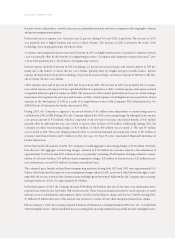American Express 2003 Annual Report Download - page 32
Download and view the complete annual report
Please find page 32 of the 2003 American Express annual report below. You can navigate through the pages in the report by either clicking on the pages listed below, or by using the keyword search tool below to find specific information within the annual report.
consolidation of variable interest entities (VIEs). The impact of the adoption is discussed in more detail in the AEFA Results
of Operations section.
On a trailing 12-month basis, return on average shareholders’ equity was 20.6 percent.
Both the Company’s revenues and expenses are affected by changes in the relative values of non-U.S. currencies to the U.S.
dollar. The currency rate changes increased both revenue and expense growth by approximately 2 percentage points in
2003, and had a negligible impact on both revenue and expense growth in 2002.
The following discussion is presented on a basis consistent with GAAP unless noted.
Revenues
Consolidated revenues were $25.9 billion, up 9 percent from $23.8 billion in 2002, reflecting 8 percent growth at TRS, 10
percent growth at AEFA and 7 percent growth at AEB. Revenues for 2002 were 5 percent higher than 2001. As discussed
below, the increase in 2003 was due to higher discount revenue and lending net finance charge revenue, greater manage-
ment and distribution fees, higher insurance and annuity revenues, higher net card fees, improved travel commissions and
fees and higher net investment income, as well as higher other revenues and net securitization income. The increase in 2002
was primarily due to increases in net investment income, discount revenue, net securitization income and insurance and
annuity revenues. These increases in 2002 were partially offset by lower management fees, weaker travel revenues and
reduced other revenues.
Discount revenue rose 11 percent during 2003 as a result of a 13 percent increase in billed business, from both growth in
cards-in-force and higher average cardmember spending, partially offset by a lower discount rate. During 2002, discount
revenue rose 3 percent as a result of a 4 percent increase in billed business partially offset by a lower discount rate.
Net investment income increased 2 percent from 2002 primarily due to higher levels of invested assets partially offset by
lower average yields and lower interest income on investment and liquidity pools held within card funding vehicles at TRS.
During 2002, net investment income increased 40 percent over 2001 primarily due to AEFA’s $1.01 billion of investment
losses during 2001.
Management and distribution fees rose 7 percent in 2003 primarily due to a 4 percent increase in management fees result-
ing from higher average assets under management and a 12 percent increase in distribution fees. Distribution fees increased
due to greater limited partnership product sales and increased brokerage-related activities. Management and distribution
fees declined 7 percent in 2002 due to lower average assets under management partially offset by higher distribution fees.
Cardmember lending net finance charge revenue at TRS increased 12 percent during 2003 due to 13 percent growth in aver-
age worldwide lending balances partially offset by lower yields. The decrease in yields versus last year reflects an increase
in the proportion of the portfolio on introductory rates and the evolving mix of products toward more lower-rate offerings,
partially offset by lower funding costs. Cardmember lending net finance charge revenue grew 7 percent during 2002 pri-
marily due to improved spreads.
Net card fees rose 6 percent in 2003 reflecting 6 percent growth in cards-in-force and the benefit of selected annual fee
increases. The average annual fee per proprietary card-in-force increased to $35 in 2003 versus $34 in both 2002 and 2001.
Net card fees increased 3 percent in 2002 reflecting growth in cards-in-force.
Travel commissions and fees increased 7 percent in 2003 due to higher revenue earned per dollar of sales coupled with a
3percent increase in travel sales, primarily due to the acquisition of Rosenbluth in the fourth quarter. Travel commissions
and fees declined 8 percent in 2002 as a result of a 10 percent contraction in travel sales reflecting the weak corporate travel
environment throughout 2002.
Insurance and annuity revenues increased 12 percent in 2003 and 15 percent in 2002 due to strong property-casualty and
higher life insurance-related revenues in both years.
(p.30_axp_ financial review)
























